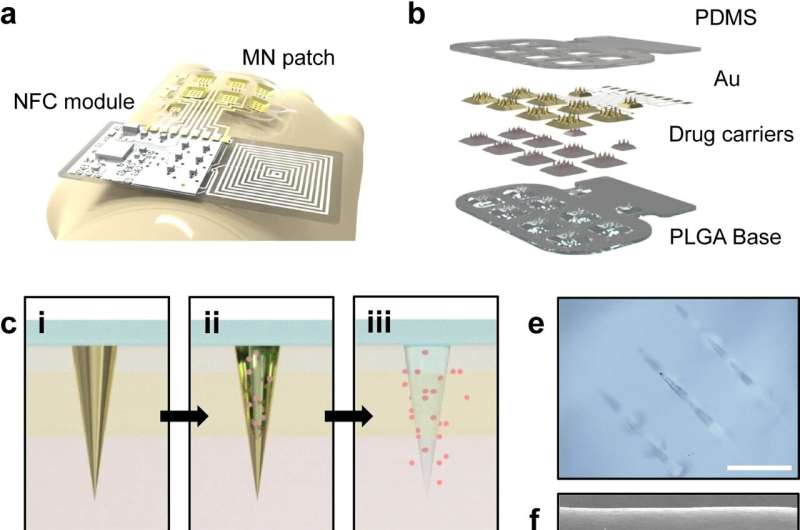This article has been reviewed according to Science X's editorial process and policies. Editors have highlighted the following attributes while ensuring the content's credibility:
fact-checked
peer-reviewed publication
trusted source
proofread
Wireless drug patch shows promise as chronic disease treatment delivery system

University of North Carolina at Chapel Hill scientists have created a new drug delivery system, called the Spatiotemporal On-Demand Patch (SOP), which can receive commands wirelessly from a smartphone or computer to schedule and trigger the release of drugs from individual microneedles. The patch's thin, soft platform resembles a Band-Aid and was designed to enhance user comfort and convenience, since wearability is a crucial factor for chronically ill patients.
The research team, led by Juan Song, Ph.D., professor of pharmacology at the UNC School of Medicine, and Wubin Bai, Ph.D., assistant professor of applied physical sciences at the UNC College of Arts and Sciences, tested the SOP in a mouse model, using melatonin in the microneedles to improve sleep.
This research, published in the journal Nature Communications, opens the door to researching this wirelessly controlled patch to deliver on-demand treatments for neurodegenerative disorders, including Alzheimer's disease.
"SOP's ability to enable joint delivery of multiple drugs could address various aspects of Alzheimer's Disease, such as reducing beta-amyloid plaques, mitigating neuroinflammation and enhancing cognitive function," said Bai, a co-senior author.
The open access paper titled, "Digital Automation of Transdermal Drug Delivery with High Spatiotemporal Resolution," was co-authored by Yihang Wang of the Department of Applied Physical Sciences and Zeka Chen of the Department of Pharmacology.
Bai said the research highlights not only a multidisciplinary collaboration but also a "passionate involvement of Carolina undergraduate students," including Priyash Hafiz of the Department of Applied Physical Sciences and Brayden Davis, Will Lipman, Tian Wang, and Sicheng Xing of the UNC/NCSU Joint Department of Biomedical Engineering.
The patch, which has received a provisional patent, enables highly localized treatment—less than 1 square millimeter—of specific tissues, organs, or regions within the body, and drug release can be triggered within 30 seconds in response to an electrical signal. Patients could wear more than one patch at a time, which would reduce the need for doctors' visits or even trips to the hospital for medical attention.
"The beauty of this device is that it can house dozens, if not hundreds, of concentrated drugs and can program their sequential release automatically," said Song, who is a member of the UNC Neuroscience Center. "Rapid drug release can be crucial in emergency situations or when immediate therapeutic action is required."
The microneedles are coated with gold, which protects the drugs and surrounding tissues. When a low-voltage electrical stimulus is applied through the patch, the gold coating disintegrates, exposing the drug-loaded microneedles to the skin and initiating the controlled release of the drugs.
"This level of specificity ensures precise and customized drug delivery, catering to the needs of different conditions or specific regions of the body," said Wang. "This offers a novel approach to achieving controlled drug release through a combination of materials science and electrical engineering."
More information: Yihang Wang et al, Digital automation of transdermal drug delivery with high spatiotemporal resolution, Nature Communications (2024). DOI: 10.1038/s41467-023-44532-0





















